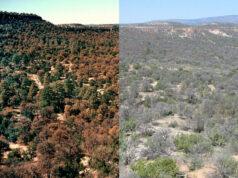Scouting Ancient Supermassive Black Holes
A team of researchers led by University of Arizona astronomers will use NASA’s James Webb Space Telescope to examine three active supermassive black holes, their host galaxies and their neighborhoods to better detail these distant objects and the conditions of the early universe.
University Communicationss and Space Telecope Science Institute
Today
STScI-01FMN264HYQDPA4QV6T8T17G98.jpeg
Researchers will use all four instruments aboard the James Webb Space Telescope to study the three most distant quasars yet discovered. They will obtain new measurements of the masses of their central supermassive black holes, detail the stars and composition of their host galaxies, and observe nearby galaxies to learn more about their “neighborhoods” in the early universe.
NASA, ESA, CSA, Joseph Olmsted (STScI)
Science and Technology
Astronomy James Webb Space Telescope Research
Media contact(s)
Researcher contact(s)
Xiaohui Fan
Steward Observatory
Find your dream job in the space industry. Check our Space Job Board »
Very distant, active supermassive black holes are the brightest beacons in the universe. Known as quasars, these behemoths are surrounded by equally distant galaxies. Gas and dust orbit these supermassive black holes and continuously rub together to create heat and light, which can be detected by telescopes.
Astronomers theorize that it can take billions of years for supermassive black holes and their accompanying galaxies to form. How is it possible that these quasars became so gigantic, with billions of solar masses, in the first 700 million years of the universe? Once you can see past their glare, what do their accompanying galaxies look like? And what do their “neighborhoods” look like?
These are questions an international team of astronomers will pursue with observations taken by NASA’s James Webb Space Telescope, which is slated for launch on Dec. 22. Xiaohui Fan, a Regents’ Professor of Astronomy at the University of Arizona’s Steward Observatory, is the principal investigator of the observing program. Jinyi Yang, the Peter A. Strittmatter Postdoctoral Fellow at Steward, and Eduardo Bañados, a staff astronomer at the Max Planck Institute for Astronomy in Heidelberg, Germany, are co-principal investigators.
The team will focus specifically on the three most distant quasars currently known. All three were discovered since 2018 by groups including UArizona astronomers, and each is located more than 13 billion light-years away.
“These distant quasars are really valuable objects,” Fan said. “We structured this program to learn everything we could think of, so our team and the greater astronomical community can fully explore these quasars.”
The James Webb Space Telescope, also known simply as Webb, will offer new views of the distant quasars in high-resolution infrared light. With that data, Fan’s team hopes to refine calculations of the quasars’ masses, detail the stars in their host galaxies and survey the galaxies in their neighborhoods. The research may influence how we view the early universe.
Webb’s sensitivity to infrared light – including mid-infrared wavelengths that can only be captured from space – will allow the team to observe these quasars, whose light has traveled for 13 billion years and had its wavelengths stretched from ultraviolet and visible light to infrared light.
Zooming in – and Out
To observe the quasars, Fan, Yang and Bañados will use almost every available instrument on Webb, including a camera developed under the leadership of a UArizona astronomer. First, they will refine the measurements of the mass of each supermassive black hole.
“The existence of these black holes challenges theoretical models,” Yang said. “We want to obtain more accurate measurements of their masses to improve our understanding of how they formed and grew so quickly.”
To increase the precision of existing measurements from other observatories, the researchers will turn to spectra – data that detail an object’s physical properties, including mass and chemical composition – delivered by Webb’s Near-Infrared Spectrograph, or NIRSpec. This will allow the team to calculate black hole masses more accurately. The team will also obtain spectra with Webb’s Mid-Infrared Instrument, or MIRI.
Next, the researchers will focus on revealing the galaxies behind the quasars’ bright light. They will take deep, detailed images of each quasar with Webb’s Near-Infrared Camera, or NIRCam, and then use computer models to remove the quasars’ light from the images. The final, processed images will provide the first views of the light from the stars in the host galaxies.
STScI-01FMN3QSHNNXHSMNN25CD2GQ8K.jpeg
Researchers will study the galaxies that surround three bright quasars in detail for the first time with the James Webb Space Telescope. First, they will take images of each target with Webb’s Near-Infrared Camera (NIRCam), like the simulated image shown at left. Next, they will remove the quasar’s light to reveal the galaxy and its stars, simulated at right. These observations will reveal the makeup of three galaxies in the early universe and add to what is understood about this time period, known as the Era of Reionization.
NASA, ESA, CSA, Joseph Olmsted (STScI)
The NIRCam instrument was developed by a group led by Marcia Rieke, a Regents’ Professor of Astronomy at Steward Observatory. George Rieke, also a Regents Professor of Astronomy, is science team lead for the Mid-Infrared Instrument.
Fan’s team also will trace how gas is moving in the quasars’ host galaxies and determine if the active supermassive black holes are sending out hot winds that heat the galaxies’ gas. Although no one can watch a complete feedback loop in real time, as it takes millions of years, the scientists can sample what’s present with NIRSpec and begin to observe the connections between the quasars and their host galaxies.
The researchers will also “zoom out” to see galaxies near the quasars. Webb’s expansive, high-resolution observations will help the team characterize the galaxies that are in the neighborhood by using Webb’s Near-Infrared Imager and Slitless Spectrograph, or NIRISS, and NIRCam.
Finally, the researchers will sample the large-scale environments around the quasars – looking at the characteristics of the gas and dust to help answer the question: What was the universe like 700 or 800 million years after the Big Bang?
“This was a period known as the Era of Reionization, when the gas between galaxies was largely opaque,” Yang explained. “Only after the first billion years of the universe did the gas become fully transparent, allowing light to travel more easily. In other words, the universe became visible for the first time.”
“These targets represent an important age of the universe – essentially the peak of this transition,” Bañados said. “Webb will provide new constraints about what this period was like.”
Fan, Yang, and Bañados will release data and tools from their observing program to the astronomical community to accelerate overall research on quasars in the early universe.
“Webb will help us make the next quantum leap in understanding these objects,” Fan said.
The following quasars are the three targets of the research program:
J0313-1806, which dates back to 670 million years after the Big Bang and is 1.6 billion times more massive than the sun
J1007+2115, or Pōniuāʻena, which dates back to 700 million years after the Big Bang and holds 1.5 billion solar masses
J1342+0928, which dates back to 690 million years after the Big Bang and is 800 million times the mass of the sun
The James Webb Space Telescope will be the world’s premier space science observatory. Webb is an international program led by NASA with the European Space Agency and the Canadian Space Agency.











